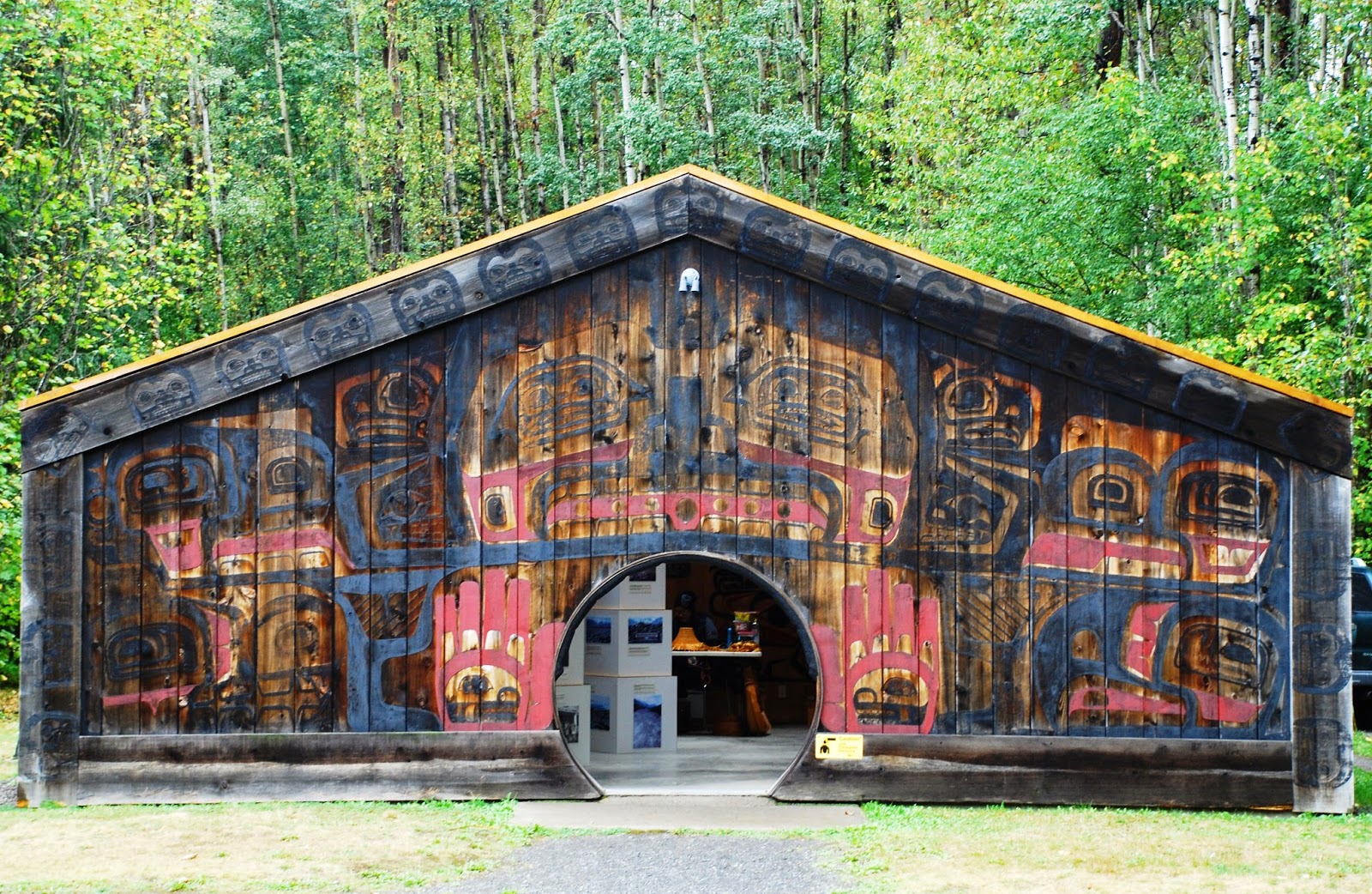Labour Day felt like it came far too quickly this year. Before I knew it, summer was over and here we were at the season's last hurrah. A final long weekend. Unfortunately, Ty and I were at odds on how to use this last slice of summer. He wanted to stay home and work on the (bloody) house, I wanted to take off (irresponsibly) for as much time as possible. In the end, like the boring adults we are becoming, we compromised and on Saturday morning, admist a soggy North Coast downpour, we took off for Anhluut’ukwsim Laxmihl Angwinga’asanskwhl Nisga’a (a.k.a. Nisga’a Memorial Lava Bed Park) for the day with Ty's sis.
 |
| The Visitor's Centre at the Park |
Ever since we first visited this part of the Nass Valley at the end of our Easter road-trip, I had been itching to go back and explore some more. Read about our first trip here. It's almost otherwordly beauty really blew me away and when I learned you could hike to the crater of the volcano that caused the massive lava bed now visible, I was determined to visit.
 |
| Turquoise creeks near the Visitor's Centre |
To visit the crater, you must take a guided hiking tour. Many people I've told about our trip have admitted to being turned off by this, either not wanting to pay money or not wanting to use a guide, they've decided against the trip. I can understand that feeling, but on the other hand, the area is not only sensitive ecologically, but also culturally, so ensuring people are using the area respectfully is much easier when visitors are monitored by a guide. The guide is a local with great knowledge of the area and Nisga'a culture, so the whole hike was so augmented by his interpretation on everything from geomorphology, the effect of the eruption on the Nisga'a people, flora and fauna, to the Nisga'a treaty In other words: fork over the (not so substantial) money and just do it.
The hike really is not difficult, but it sure is pretty. After a very bumpy drive in the very tiny truck of our guide, we arrived at the trailhead. After a quick briefing and welcome in Nisga'a language by our guide Steve, we began. Descending through some lush second and then first growth, the ground under your feet becomes a bit crunchy as you begin to tromp on thin soil over layers of volcanic ash. Steve stopped to tell us stories about wildlife in the area and the trees around us.
 |
| Trail. So. Green. |
 |
| Volcanic mud in the streambeds. |
 |
| The creeks appeared to be running with milk due to the silty runoff. |
Soon, we began to notice black volcanic mud around the creek beds, which were eerily flowing with what looked like milk (apparently they'd been dry all summer long and had just began to flow again due to the recent rains, hence the silty, milky looking runoff). After a short time, we exited the tree canopy into the awesome lava landscape that the park is known for. Around us, black jagged rocks were covered in all manner of lichens and moss. According to our guide Steve, the cover of lichens had grown exponentially in recent years and more and more vascular plants are taking hold as well.
 |
| Lichen Love. |
 |
The trail on the lava beds.
|
 |
| A volcanic cone. It is so well-insulated that ice remained in the bottom despite the warm summer. |
I'll admit that when we got to the crater, it was a little anticlimatic..mostly because there is no boiling lava or steam, which is totally logical when you realize this volcano erupted over 2 centuries ago. Sitting on the lip, however, Steve shared some of his smoked salmon and explained how the eruption happened, the terrifying effect on the communities below (over 2000 people perished) and showed us the various types of rock that exploded from this very crater. Some, dubbed 'bombs', are incredibly heavy, while others are as light as styrofoam due to gases expelled and trapped during the eruption.
 |
| The crater. |
 |
| Three types (and weights) of volcanic rock. The 'bomb' is on the right. |
The trail is a there-and-back, so you retrace your steps on return. It's another opportunity to notice the beautiful little microcosms growing out of the lava and to contemplate the severity of this event on the people and landscape. It also gave us more opportunity to chat with Steve about his community and his perspectives on current Nisga'a politics.
It was a great way to spend a chunk of the day and I'd definitely highlight a visit to the Nass Valley to any potential north coast visitors. On top of this beauty little hike, there are hot springs, a lovely museum, and some gorgeous drives in the area. Steve even told us about a resident Spirit bear that can sometimes be spotted just outside the entrance to the park!!! There is much more I'd like to see in the area, so I am sure we'll be back. If you want to visit yourself, learn more about the park
here.
PS. I fully acknowledge that my posts are too long, with too many photos. But...SO PRETTY, ya know?















Not too long Cait. Many of us have more than twitter length attention spans!
ReplyDelete